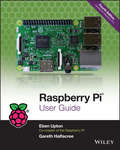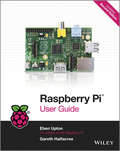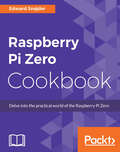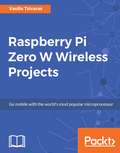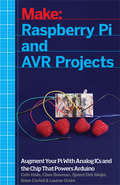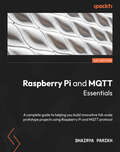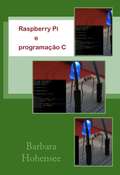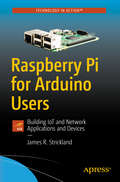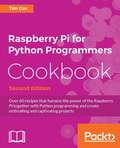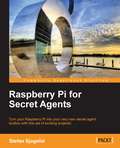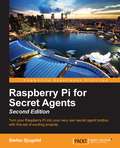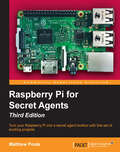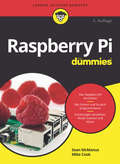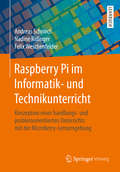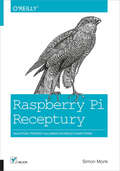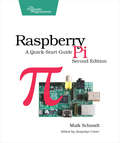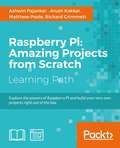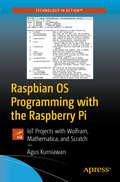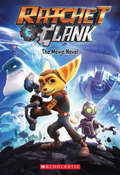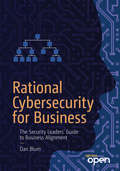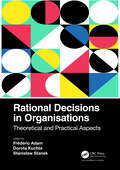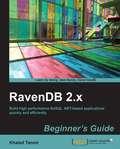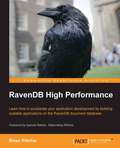- Table View
- List View
Raspberry Pi User Guide
by Gareth Halfacree Eben UptonLearn the Raspberry Pi 3 from the experts! Raspberry Pi User Guide, 4th Edition is the "unofficial official" guide to everything Raspberry Pi 3. Written by the Pi's creator and a leading Pi guru, this book goes straight to the source to bring you the ultimate Raspberry Pi 3 manual. This new fourth edition has been updated to cover the Raspberry Pi 3 board and software, with detailed discussion on its wide array of configurations, languages, and applications. You'll learn how to take full advantage of the mighty Pi's full capabilities, and then expand those capabilities even more with add-on technologies. You'll write productivity and multimedia programs, and learn flexible programming languages that allow you to shape your Raspberry Pi into whatever you want it to be. If you're ready to jump right in, this book gets you started with clear, step-by-step instruction from software installation to system customization. The Raspberry Pi's tremendous popularity has spawned an entire industry of add-ons, parts, hacks, ideas, and inventions. The movement is growing, and pushing the boundaries of possibility along with it—are you ready to be a part of it? This book is your ideal companion for claiming your piece of the Pi. Get all set up with software, and connect to other devices Understand Linux System Admin nomenclature and conventions Write your own programs using Python and Scratch Extend the Pi's capabilities with add-ons like Wi-Fi dongles, a touch screen, and more The credit-card sized Raspberry Pi has become a global phenomenon. Created by the Raspberry Pi Foundation to get kids interested in programming, this tiny computer kick-started a movement of tinkerers, thinkers, experimenters, and inventors. Where will your Raspberry Pi 3 take you? The Raspberry Pi User Guide, 3rd Edition is your ultimate roadmap to discovery.
Raspberry Pi User Guide
by Gareth Halfacree Eben UptonThe essential guide to getting started with the Raspberry Pi ® The Raspberry Pi has been a success beyond the dream of its creators. Their goal, to encourage a new generation of computer programmers who understand how computers work, is well under way. Raspberry Pi User Guide 2e is the newest edition of the runaway bestseller written by the Pi’s co-creator, Eben Upton, and tech writer Gareth Halfacree. It contains everything you need to know to get the Pi up and running, including how to: Connect a keyboard, mouse, monitor and other peripherals Install software and configure your Raspberry Pi Master basic Linux system administration Set up your Raspberry Pi as a productivity machine, multimedia centre, or web server Write programmes in Scratch and Python Use the GPIO port and add-on boards to connect your Raspberry Pi for use in electronics projects Updated to cover the release of the Camera Board, the introduction of the Pi Store, NOOBS and much more, Raspberry Pi User Guide 2nd edition is the perfect companion for getting the most out of the computing phenomenon, the Raspberry Pi. Eben Upton is the co-creator of the Raspberry Pi board and the founder of the Raspberry Pi Foundation. Gareth Halfacree is a freelance technology journalist, open source advocate and erstwhile sysadmin.
Raspberry Pi Zero Cookbook
by Edward SnajderOver 80 practical and interesting recipes that explore the plethora of functionalities and opportunities available with Raspberry Pi Zero About This Book • Deep dive into the components of the small yet powerful Raspberry Pi Zero • Get into grips with integrating various hardware, programming, and networking concepts with the so-called “cheapest computer” • Explore the functionalities of this $5 chip through practical recipes Who This Book Is For This book is for programmers and hobbyists who are eager to dive deep into the Raspberry Pi Zero. If you have basic or zero knowledge of the Raspberry Pi Zero, or if you looking for examples of ways to utilize the Raspberry Pi's GPIO interface, then this book is ideal for you. Basic knowledge of Python will be beneficial, and experience with circuitry and electronics will be needed for the later chapters in the book. What You Will Learn • Set up your Raspberry Pi Zero with the operating system, networking, and different interfaces • Get a hands-on introduction to Linux, Python, and shell scripts with the Raspberry Pi Zero • Become a master at driving GPIOs and controlling relays, motors, transistors, buzzers, audio, read switches, and interrupts with the Raspberry Pi Zero • Control GPIOs using the web interface and Node.js • Connect displays, LED matrixes, analog sensors, and digital sensors • Hack the Ethernet on the Raspberry Pi Zero • Make your Raspberry Pi Zero an IoT-based sensor node and remotely monitor your data In Detail The Raspberry Pi Zero, one of the most inexpensive, fully-functional computers available, is a powerful and revolutionary product developed by the Raspberry Pi Foundation. The Raspberry Pi Zero opens up a new world for the makers out there. This book will give you expertise with the Raspberry Pi Zero, providing all the necessary recipes that will get you up and running. In this book, you will learn how to prepare your own circuits rather than buying the expensive add–ons available in the market. We start by showing you how to set up and manage the Pi Zero and then move on to configuring the hardware, running it with Linux, and programming it with Python scripts. Later, we integrate the Raspberry Pi Zero with sensors, motors, and other hardware. You will also get hands-on with interesting projects in media centers, IoT, and more. Style and approach This recipe-based book will ensure you gain an intermediate-level knowledge of the Raspberry Pi Zero. This book contains comprehensive illustrations with specific schematics for each circuit diagram.
Raspberry Pi Zero W Wireless Projects
by Vasilis TzivarasBuild DIY wireless projects using the Raspberry Pi Zero W board About This Book • Explore the functionalities of the Raspberry Pi Zero W with exciting projects • Master the wireless features (and extend the use cases) of this $10 chip • A project-based guide that will teach you to build simple yet exciting projects using the Raspberry Pi Zero W board Who This Book Is For If you are a hobbyist or an enthusiast and want to get your hands on the latest Raspberry Pi Zero W to build exciting wireless projects, then this book is for you. Some prior programming knowledge, with some experience in electronics, would be useful. What You Will Learn • Set up a router and connect Raspberry Pi Zero W to the internet • Create a two-wheel mobile robot and control it from your Android device • Build an automated home bot assistant device • Host your personal website with the help of Raspberry Pi Zero W • Connect Raspberry Pi Zero to speakers to play your favorite music • Set up a web camera connected to the Raspberry Pi Zero W and add another security layer to your home automation In Detail The Raspberry Pi has always been the go–to, lightweight ARM-based computer. The recent launch of the Pi Zero W has not disappointed its audience with its $10 release. "W" here stands for Wireless, denoting that the Raspberry Pi is solely focused on the recent trends for wireless tools and the relevant use cases. This is where our book—Raspberry Pi Zero W Wireless Projects—comes into its own. Each chapter will help you design and build a few DIY projects using the Raspberry Pi Zero W board. First, you will learn how to create a wireless decentralized chat service (client-client) using the Raspberry Pi's features?. Then you will make a simple two-wheel mobile robot and control it via your Android device over your local Wi-Fi network. Further, you will use the board to design a home bot that can be connected to plenty of devices in your home. The next two projects build a simple web streaming security layer using a web camera and portable speakers that will adjust the playlist according to your mood. You will also build a home server to host files and websites using the board. Towards the end, you will create free Alexa voice recognition software and an FPV Pi Camera, which can be used to monitor a system, watch a movie, spy on something, remotely control a drone, and more. By the end of this book, you will have developed the skills required to build exciting and complex projects with Raspberry Pi Zero W. Style and approach A step-by-step guide that will help you design and create simple yet exciting projects using the Raspberry Pi Zero W board.
Raspberry Pi and AVR Projects: Augmenting the Pi's ARM with the Atmel ATmega, ICs, and Sensors
by Troy Mott Sjoerd Dirk Meijer Lauren Orsini Clare Bowman Brian Corteil Cefn HoileAs an incredibly cheap, credit-card sized computer, the Raspberry Pi is breaking down barriers by encouraging people of all ages to experiment with code and build new systems and objects; and this book provides readers with inspiring and insightful examples to explore and build upon. Written for intermediate to seasoned Raspberry Pi users, this book explores four projects from around the world, explained by their makers. These projects cover five major categories in the digital maker space: music, light, games, home automation, and the Internet of Things.
Raspberry Pi and MQTT Essentials: A complete guide to helping you build innovative full-scale prototype projects using Raspberry Pi and MQTT protocol
by Dhairya ParikhGet familiar with all the concepts related to Raspberry Pi and MQTT, build innovative IoT projects, and discover how to scale these projects to the next levelKey FeaturesLearn some of the most popular tools used in IoT – Raspberry Pi, MQTT, ESP8266 and moreBuild exciting projects such as an IoT weather station and a smart switch boardDiscover the advantages of taking your MQTT broker globalBook DescriptionThe future of IoT has the potential to be limitless. Wouldn't it be great if you could add it to your own technological stacks? But where to start? With the basics, of course. In this book, you will start by learning about the most popular hardware and communication protocol, Raspberry Pi and MQTT. You will see how to use them together by setting up your own MQTT server on Raspberry Pi and understand how it works. This book explores MQTT in detail, including the clients and devices that you can connect to your server. You will discover two very popular IoT development boards among project developers: the ESP8266 and ESP32 development boards. Then, you will learn how to build interactive dashboards on your Pi and monitor your client devices. The book also shows you how to build a dashboard using another popular software – Node-RED. You will be able to put your skills to the test by creating two full-scale projects. That's not all: you will also learn how to host your own MQTT server on a virtual cloud service. Finally, you will be guided on how to move forward from here, what technologies to learn, and some project recommendations to polish or test your knowledge. By the end of this book, you will be able to build meaningful projects using Raspberry Pi and MQTT and create dashboards for your projects on Node-RED.What you will learnConfigure and use a Raspberry Pi for IoT projectsImplement the MQTT communication protocol for projectsUnderstand how to set up the NodeMCU and ESP32 boards as MQTT clientsControl a NodeMCU board through a Node-RED dashboard hosted on Raspberry PiGet LAMP server, Home Assistant, and MariaDB on the Raspberry PiSet up an online MQTT broker on a cloud service or enterprise service provider platformBuild full-scale, end-to-end prototype projectsWho this book is forThis book is for students who are interested in IoT and want to build projects using the available developer hardware. Educators who want to introduce a course on IoT into their curriculum, technology enthusiasts, and IoT developers who are just getting started will also benefit from this book. No prior knowledge about the two main topics that the book covers is required - Raspberry Pi and MQTT. A basic understanding of what IoT is will also be useful but not mandatory.
Raspberry Pi e programação C
by Barbara Hohensee Jonathan R. Santos e Aleff E. OliveiraAprenda o básico da programação em C e contrua projetos embarcados usando Raspberry Pi e a linguagem C.
Raspberry Pi for Arduino Users: Building IoT and Network Applications and Devices
by James R. StricklandLeverage your Arduino skills in the Raspberry Pi world and see how to cross the two platforms into sophisticated programs.The Arduino and Raspberry Pi communities overlap more than you might think. Arduinos can be expanded to have network capabilities with a variety of “shields,” all of which increase the cost and complexity of the system. By contrast, Raspberry Pis all run Linux, which is a very network-competent platform. The newest Pi, the Raspberry Pi Zero W, is WiFi and Bluetooth capable, and costs around $10 U.S. For network enabled gadgets, it makes far more sense to cross to the Raspberry PI platform, if only someone would make it easy to do. That's what this book is about.You'll learn some survival level Linux system administration, so you know how to set the machine up and how to establish at least minimal security for your gadget. You''ll set up and learn the Geany IDE on your Pi, which is fairly similar to the Arduino IDE. Where the two platforms overlap the most is the GPIO system. You'll see that several projects use and explain the WiringPi system. This is is deliberately similar to the Arduino's 'Wiring' functionality, which is how sketches interact with GPIO pins. You'll learn the differences between the GPIO pins of the two devices, and how the Pi has some limitations on those pins that the Arduino does not. As a final project, in an effort to escape some of those limitations, you'll attach an AtMEGA 328P to the Raspberry Pi and configure it as a real, 8MHz Arduino with the Arduino IDE running on the Pi, and learn how to have the two platforms communicate, giving you the best of both worlds.What You'll LearnEstablish security with Linux system administrationSet up the Apache webserverWrite CGI programs so other computers can connect to your Pi and pull data in from it. Use C/C++ from Arduino sketches to write programs for the Pi Who This Book Is For The Arduino user who's been through all the tutorials and is comfortable writing sketches and connecting hardware to their Arduino.
Raspberry Pi for Python Programmers Cookbook - Second Edition
by Tim CoxOver 60 recipes that harness the power of the Raspberry Pi together with Python programming and create enthralling and captivating projects About This Book • Install your first operating system, share files over the network, and run programs remotely • Construct robots and interface with your own circuits and purpose built add-ons, as well as adapt off-the-shelf household devices using this pragmatic guide • Packed with clear, step-by-step recipes to walk you through the capabilities of Raspberry Pi Who This Book Is For Readers are expected to be familiar with programming concepts and Python (where possible Python 3 is used), although beginners should manage with the help of a good Python reference book and background reading. No prior knowledge of the Raspberry Pi or electronics is required; however, for the hardware sections you will need some basic electronic components/household tools to build some of the projects. What You Will Learn • Get the Raspberry Pi set up and running for the first time • Remotely connect to the Raspberry Pi and use your PC/laptop instead of a separate screen/keyboard • Get to grips with text, files and creating quick menus using Python • Develop desktop applications; handle images and process files with ease • Make use of graphics and user control to develop your own exciting games • Use the Raspberry Pi's powerful GPU to create 3D worlds • Take control of the real world and interface with physical hardware, combining hardware and software for your own needs • Measure and control processes, respond to real events and monitor through the Internet • Learn about the Raspberry Pi hardware inputs/outputs, starting with the basics and beyond • Expand the capabilities of the Raspberry Pi with hardware expansion / add-on modules (use analogue inputs, drive servos and motors, and use SPI/I2C) • Create your own Pi-Rover or Pi-Hexpod driven by the Raspberry Pi • Make use of existing hardware by modifying and interfacing with it using the Raspberry Pi In Detail Raspberry Pi cookbook for Python Programmers is a practical guide for getting the most out of this little computer. This book begins by guiding you through setting up the Raspberry Pi, performing tasks using Python 3 and introduces the first steps to interface with electronics. As you work through each chapter you will build up your skills and knowledge and apply them as you progress throughout the book, delving further and further into the unique abilities and features of the Raspberry Pi. Later, you will learn how to automate tasks by accessing files, build applications using the popular Tkinter library and create games by controlling graphics on screen. You will harness the power of the built-in graphics processor by using Pi3D to generate your own high quality 3D graphics and environments. Connect directly to the Raspberry Pi's hardware pins to control electronics from switching on LEDs and responding to push buttons right through to driving motors and servos. Learn how to monitor sensors to gather real life data and to use it to control other devices, and view the results over the Internet. Apply what you have learnt by creating your own Pi-Rover or Pi-Hexipod robots. Finally, we will explore using many of the purpose built add-ons available for the Raspberry Pi, as well as interfacing with common household devices in new ways. Style and approach Written in a cookbook style, the book contains a series of recipes on various topics, ranging from simple to complex. It is an easy-to-follow and step-by-step guide with examples of various feature integration suitable for any search application.
Raspberry Pi for Secret Agents
by Stefan SjogelidA playful, informal approach to using the Raspberry Pi for mischief!Raspberry Pi for Secret Agents is for all mischievous Raspberry Pi owners who'd like to see their computer transform into a neat spy gadget to be used in a series of practical pranks and projects. No previous skills are required to follow along and if you're completely new to Linux, you'll pick up much of the basics for free.Apart from the Raspberry Pi board itself, a USB microphone and/or a webcam is required for most of the audio/video topics and a Wi-Fi dongle is recommended for the networking examples. A Windows/Mac OS X/Linux computer (or second Raspberry Pi) is also recommended for remote network access.
Raspberry Pi for Secret Agents - Second Edition
by Stefan SjogelidThis book is an easy-to-follow guide with practical examples in each chapter. Suitable for the novice and expert alike, each topic provides a fast and easy way to get started with exciting applications and also guides you through setting up the Raspberry Pi as a secret agent toolbox.
Raspberry Pi for Secret Agents - Third Edition
by Matthew PooleTurn your Raspberry Pi into a secret agent toolbox with this set of exciting projects About This Book • Turn your Raspberry Pi into a multi-purpose secret agent gadget for audio and video surveillance, Wi-Fi exploration, or playing pranks on your friends • Detect an intruder on camera or with sensors and set off an alarm or receive messages to your phone • Find out what the other computers on your network are up to and make yourself anonymous on the Internet • This book has been updated for new additions to your toolkit featuring the tiny, recently released Raspberry Pi Zero board Who This Book Is For This book is for those who are new to the Raspberry Pi Zero ,Raspberry Pi 2 or Raspberry Pi 3 and have some experience with the original Raspberry Pi models, and even for those budding secret agents who would like to use Pi Zero as a secret agent toolbox. No programming experience is assumed. Suitable for the novice and expert alike, each topic provides a fast and easy way to get started with exciting applications, with practical examples in every chapter. What You Will Learn • Install and configure the Raspbian Jessie operating system for maximum mischief • Detect an intruder with motion detection or a laser trip wire and set off an alarm • Listen in to conversations from a distance over Bluetooth • Distort your voice in weird and wonderful ways • Track the Pi's whereabouts using GPS • Connect your Pi to the mobile Internet using a 3G dongle and make yourself anonymous on the net • Display secret messages and codes to fellow agents on a LED display In Detail This book is for all mischievous Raspberry Pi owners who'd like to see their computer transform into a neat spy gadget to be used in a series of practical pranks and projects. No previous skills are required to follow along, and if you're completely new to Linux, you'll pick up much of the basics for free. We'll help you set up your Raspberry Pi Zero , Raspberry Pi 2 and Raspberry Pi 3 and guide you through a number of pranks and secret agent techniques that are so inconspicuous yet high on mischief. You'll learn how to configure your operating system for maximum mischief and start exploring audio, video, or Wi-Fi techniques. We'll show you how to record, listen, or talk to people from a distance and how to set up your own phone network. Then, you'll plug in your webcam and set up a motion detector with an alarm and find out what the other computers on your Wi-Fi network are up to. Once you've mastered the techniques, we'll combine them with a battery pack and GPS for the ultimate off-road spy kit. Style and Approach This easy-to-follow guide is for budding secret agents who want to create tools for mischief, stealth, and reconnaissance. It's full of fun, practical examples and easy-to-follow recipes, guaranteeing maximum mischief for all skill levels.
Raspberry Pi für Dummies (Für Dummies)
by Mike Cook Sean McManusSean McManus und Mike Cook führen Sie Schritt für Schritt in die Nutzung des Raspberry Pi ein und verschaffen Ihnen einen Überblick über all die Möglichkeiten, die er Ihnen bietet. Sie zeigen Ihnen, wie Sie den Raspberry Pi zum Laufen bringen, sich unter Linux zurechtfinden, den Raspberry Pi als ganz normalen Computer mit Office- und Bildverarbeitungsprogrammen oder als Mediencenter zum Abspielen von Musik und Videos nutzen. Außerdem lernen Sie, wie Sie die Platine mit Scratch und Python programmieren, und erfahren alles über die Verwendung des Raspberry Pi als Steuereinheit für elektronisches Spielzeug.
Raspberry Pi im Informatik- und Technikunterricht: Konzeption eines handlungs- und problemorientierten Unterrichts mit der MicroBerry-Lernumgebung
by Andreas Schnirch Nadine Ridinger Felix WeschenfelderDieses Buch beschreibt erprobte und evaluierte Unterrichtssequenzen zum Experimentieren mit dem Raspberry Pi im Informatik- und Technikunterricht der Sekundarstufe. Ausgehend von den Zielen eines modernen Informatikunterrichts wird gezeigt, wie eine interessen- und motivationsfördernde Raspberry-Pi Lernumgebung aussehen kann. Neben konkreten und differenzierten Unterrichtseinheiten, mit denen sich Schülerinnen und Schüler experimentell die Grundbausteine von Algorithmen erschließen können, werden Unterrichtseinheiten für fortgeschrittene Lernende sowie Projekte vorgestellt. Die vorgestellten Konzepte unterstützen Lehrerinnen und Lehrer wirkungsvoll bei der Konzeption des eigenen Unterrichts, können aber auch als Selbstlernmodule genutzt werden.
Raspberry Pi. Receptury
by Simon MonkWyobra? sobie komputer o rozmiarach niewiele wi?kszych od karty kredytowej, posiadaj?cy ca?kiem spor? moc obliczeniow?, pracuj?cy pod kontrol? systemu Linux i kosztuj?cy grosze. Tak, taki sprz?t istnieje naprawd?! Mowa o Raspberry Pi — urz?dzeniu zaprojektowanym z my?l? o nauce programowania dla dzieci, które sprawdzi?o si? w wielu zastosowaniach i odnios?o ogromny sukces na rynku komercyjnym jako serwer WWW, odtwarzacz filmów oraz platforma do budowy niezwyk?ych projektów elektronicznych. Brzmi intryguj?co?Otwórz t? ksi??k? i poznaj najlepsze przepisy na wykorzystanie mo?liwo?ci Raspberry Pi. St?d dowiesz si? wszystkiego o budowie i mo?liwo?ciach tego urz?dzenia. Po lekturze kolejnych rozdzia?ów pod??czysz Pi do sieci — zarówno kablowej, jak i bezprzewodowej, oraz wykorzystasz z??cza GPIO. Ponadto poznasz podstawy j?zyka Python i zobaczysz, jak zastosowa? go w Pi. Po lekturze tej ksi??ki b?dziesz umia? samodzielnie sterowa? sprz?tem elektronicznym i silnikami oraz zbiera? dane z czujników ró?nego typu. Ksi??ka ta jest obowi?zkow? pozycj? dla ka?dego posiadacza tej niezwyk?ej platformy! Dzi?ki tej ksi??ce: rozpoczniesz prac? z Raspberry Pi, pod??czysz Raspberry Pi do sieci, b?dziesz pracowa? w ?rodowisku opartym na systemie Linux, skorzystasz z gotowych aplikacji przeznaczonych dla Raspberry Pi, b?dziesz sterowa? prac? elektroniki pod??czonej do z??cza GPIO, poznasz zagadnienia dotycz?ce sterowania za pomoc? Raspberry Pi prac? ró?nych silników, rozpoczniesz prac? z prze??cznikami, blokami klawiszy i innymi cyfrowymi urz?dzeniami wej?ciowymi, wykonasz ró?ne pomiary za pomoc? czujników pod??czonych do Raspberry Pi, pod??czysz do Raspberry Pi ró?ne wy?wietlacze — mi?dzy innymi matryce diodowe, stworzysz dynamiczne projekty korzystaj?ce z mo?liwo?ci Arduino i Raspberry Pi. Twój przewodnik po platformie Raspberry Pi!
Raspberry Pi: A Quick-Start Guide
by Maik SchmidtPrinted in full color.Most of the book is targeted at beginners in computing and programming. A few parts, such as the small electronics project and setting up a web server, assume some intermediate skills.The Raspberry Pi is one of the most successful open source hardware projects ever. For less than $40, you get a full-blown PC, a multimedia center, and a web server--and this book gives you everything you need to get started. You'll learn the basics, progress to controlling the Pi, and then build your own electronics projects. This new edition is revised and updated with two new chapters on adding digital and analog sensors, and creating videos and a burglar alarm with the Pi camera. Get your Raspberry Pi up and running and doing cool stuff. You'll start with the basics: adding hardware, installing and configuring Debian Linux, and customizing the Pi's firmware to get the most out of your hardware.Then the fun begins. You'll connect the Pi to your home network, surf the web, and tweet messages. You'll learn how to get the most out of Midori, the Pi's standard browser, and control the desktops of other PCs with the Pi. Then you'll explore the Pi's versatility with a series of home projects. Turn it into a web server in your home network; convert the Pi into a powerful multimedia center so you can watch high-definition video and listen to your favorite music; and play classic video games.Then you'll use the GPIO pins on the Raspberry Pi to build your own electronics projects, such as an "out of memory" alarm. You'll learn how to use digital and analog sensors with the Pi, even though the Pi doesn't have analog input ports! Finally, you'll set up the Pi camera, create your own time-lapse videos, and build an automatic e-mailing burglar alarm. Power to the Pi!What You NeedYou need a Raspberry Pi and several things that you probably already have at home, such as a keyboard, a mouse, a monitor/TV set, and an SD card. To build the electronic projects you need a few cheap parts and the Pi camera.
Raspberry Pi: Making Amazing Projects Right from Scratch!
by Matthew Poole Richard Grimmett Ashwin Pajankar Arush KakkarExplore the powers of Raspberry Pi and build your very own projects right out of the box About This Book * From robotics to gaming, this Learning Path will unlock your creativity! * Build your own impressive IoT projects to transform your home * Featuring some of Packt's very best Raspberry Pi content, this Learning Path doesn't just get you to your destination - it opens up a whole horizon of possibilities! Who This Book Is For Want new ideas for your next Raspberry Pi project? Got one lying around gathering dust? This Learning Path gets you straight into the creative dirty work of programming and playing with your pi. Whether your new to Raspberry Pi, or an experienced maker, we think this Learning Path will inspire you and get your creative juices flowing! What You Will Learn * Discover an aweome range of Raspberry Pi projects * Bridge the gap between software and hardware through your Pi and find out how to make an operating system interact with cameras and other hardware * Find out how to use your Raspberry Pi for gaming * Secure your home with this tiny computer! * Make science fiction a reality - build a walking robot In Detail Looking for inspiration for your next Raspberry Pi project? Not sure where to begin? This Learning Path is the perfect place to begin, providing you with an accessible yet comprehensive journey through Raspberry Pi. Following three modules, you'll soon be confident and prepared to get creative with your microcomputer. Raspberry Pi by Example is the first module in this Learning Path - and it does exactly what it says. It doesn't just teach, it shows you how to go and build some awesome Raspberry Pi projects immediately. Build and play your own games with the Pi, build a complete Internet of Things home automation system that controls your house through Twitter... let your imagination run wild! In the next module we'll look in more depth at building a home security system. You'll be using some of the skills you devoped through the first module, but apply them to something more intricate and impressive. Using a Linux based operating system as the foundations, you'll gradually build up an entire security infrastructure adding cameras, remote controls, and even intrusion alerts! In the final module, we'll take you into the world of Raspberry Pi robotics. By the end of it, you'll have built a biped robot that can interact with its environment! This Learning Path combines some of the best that Packt has to offer in one complete, curated package. It includes content from the following Packt products: * Raspberry Pi By Example by Ashwin Pajankar and Arush Kakkar * Building a Home Security System with Raspberry Pi by Matthew Pole * Raspberry Pi Robotics Essentials by Richard Grimmett Style and approach It's not every day you build a home automation system. It's not every day you build a walking robot. But with this Learning Path you'll do just that. So get started and let this tiny computer expand your imagination.
Raspbian OS Programming with the Raspberry Pi: IoT Projects with Wolfram, Mathematica, and Scratch
by Agus KurniawanMaster the command line and Raspbian Linux as well as the physical connections of the Pi. With this book you’ll develop skills applicable to other real world applications in both hardware and software development all while working on simple and fun IoT projects that you can do yourself.You'll learn to build programs on the top of Raspbian OS in Raspberry Pi boards. Start by using Raspbian shells to develop programs.Then follow projects and samples step-by-step to get new experiences in Raspbian OS development. You'll also learn the Wolfram Language and Mathematica, Scratch, IoT programs and IoT middleware, Node-RED, Interactive Data Visualization with Jupyter Notebook, and more.There are many features in Raspbian OS and on Raspberry Pi boards perfect for building an IoT program to suite various scenarios. The GPIO pins on your Raspberry Pi allow it to scale further to accomplish all kinds of projects and tasks. Raspbian OS Programming with the Raspberry Pi is your pathway to exploring all of this.What You'll LearnDiscover the basics of programming in the Raspbian OS environment Work with the Raspbian Commandline Develop programs with the Wolfram Language and MathematicaWho This Book Is ForStudents and hobbyists interested in programming on Raspbian OS with Raspberry Pi boards.
Ratchet and Clank: Hero Time (Movie Reader)
by Scholastic Meredith RusuWhen the evil alien Drek decides to destroy every planet in the Solana Galaxy, the Galactic Rangers turn to two unlikely heroes for assistance: Ratchet, a rare Lombax who works as a mechanic, and Clank, a castoff robot from Drek's own forces. Can they work together to stop Drek and save the galaxy? This 48-page reader is packed with pictures from the movie and is geared toward kids ages 5-8.
Ratchet and Clank: The Movie Novel
by Scholastic Kate HowardWhen the evil alien Drek decides to destroy every planet in the Solana Galaxy, the Galactic Rangers turn to two unlikely heroes for assistance: Ratchet, a rare Lombax who works as a mechanic, and Clank, a castoff robot from Drek's own forces. Can they work together to stop Drek and save the galaxy?
Rational Cybersecurity for Business: The Security Leaders' Guide to Business Alignment
by Dan BlumUse the guidance in this comprehensive field guide to gain the support of your top executives for aligning a rational cybersecurity plan with your business. You will learn how to improve working relationships with stakeholders in complex digital businesses, IT, and development environments. You will know how to prioritize your security program, and motivate and retain your team.Misalignment between security and your business can start at the top at the C-suite or happen at the line of business, IT, development, or user level. It has a corrosive effect on any security project it touches. But it does not have to be like this. Author Dan Blum presents valuable lessons learned from interviews with over 70 security and business leaders. You will discover how to successfully solve issues related to: risk management, operational security, privacy protection, hybrid cloud management, security culture and user awareness, and communication challenges.This open access book presents six priority areas to focus on to maximize the effectiveness of your cybersecurity program: risk management, control baseline, security culture, IT rationalization, access control, and cyber-resilience. Common challenges and good practices are provided for businesses of different types and sizes. And more than 50 specific keys to alignment are included.What You Will LearnImprove your security culture: clarify security-related roles, communicate effectively to businesspeople, and hire, motivate, or retain outstanding security staff by creating a sense of efficacy Develop a consistent accountability model, information risk taxonomy, and risk management framework Adopt a security and risk governance model consistent with your business structure or culture, manage policy, and optimize security budgeting within the larger business unit and CIO organization IT spend Tailor a control baseline to your organization’s maturity level, regulatory requirements, scale, circumstances, and critical assets Help CIOs, Chief Digital Officers, and other executives to develop an IT strategy for curating cloud solutions and reducing shadow IT, building up DevSecOps and Disciplined Agile, and moreBalance access control and accountability approaches, leverage modern digital identity standards to improve digital relationships, and provide data governance and privacy-enhancing capabilitiesPlan for cyber-resilience: work with the SOC, IT, business groups, and external sources to coordinate incident response and to recover from outages and come back stronger Integrate your learnings from this book into a quick-hitting rational cybersecurity success plan Who This Book Is For Chief Information Security Officers (CISOs) and other heads of security, security directors and managers, security architects and project leads, and other team members providing security leadership to your business
Rational Decisions in Organisations: Theoretical and Practical Aspects
by Frédéric AdamManagers in organisations must make rational decisions. Rational decision making is the opposite of intuitive decision making. It is a strict procedure utilising objective knowledge and logic. It involves identifying the problem to solve, gathering facts, identifying options and outcomes, analysing them, considering all the relationships and selecting the decision. Rational decision making requires support: methods and software tools. The identification of the problem to solve needs methods that would measure and evaluate the current situation. Identification and evaluation of options and analysis of the available possibilities involves analysis and optimisation methods. Incorporating intuition into rational decision making needs adequate methods that would translate ideas or observed behaviours into hard data. Communication, observation and opinions recording is hardly possible today without adequate software. Information and data that form the input, intermediate variables and the output must be stored, managed and made accessible in a user-friendly manner. Rational Decisions in Organisations: Theoretical and Practical Aspects presents selected recent developments in the support of the widely understood rational decision making in organisations, illustrated through case studies. The book shows not only the variety of perspectives involved in decision making, but also the variety of domains where rational decision support systems are needed. The case studies present decision making by medical doctors, students and managers of various universities, IT project teams, construction companies, banks and small and large manufacturing companies. Covering the richness of relationships in which the decisions should and must be taken, the book illustrates how modern organisations operate in chains and networks; they have multiple responsibilities, including social, legal, business and ethical duties. Nowadays, managers in organisations can make transparent decisions and consider a multitude of stakeholders and their diverse features, incorporating diverse criteria, using multiple types and drivers of information and decision-making patterns, and referring to numerous lessons learned. As the book makes clear, the marriage of theoretical ideas with the possibilities offered by technology can make the decisions in organisations more rational and, at the same time, more human.
RavenDB 2.x beginner's guide
by Khaled TannirWritten in a friendly, example-driven Beginner's Guide format, there are plenty of step-by-step instructions and examples that are designed to help you get started with RavenDB. If you are a .NET developer, new to document-oriented databases, and you wish to learn how to build applications using NoSQL databases, then this book is for you. Experience with relational database systems will be helpful, but not necessary.
RavenDB High Performance
by Brian RitchieRavenDB High Performance is comprehensive yet concise tutorial that developers can use to.This book is for developers & software architects who are designing systems in order to achieve high performance right from the start. A basic understanding of RavenDB is recommended, but not required. While the book focuses on advanced topics, it does not assume that the reader has a great deal of prior knowledge of working with RavenDB.
Raving Patients: The Definitive Guide To Using Reputation Marketing To Attract Hundreds Of New Patients
by Len TauIn Raving Patients, Dr. Len Tau, a practicing dentist in Philadelphia and online reputation specialist, shares simple tips and best practices to become visible and demonstrate credibility online. Dental practices waste thousands of dollars and hundreds of hours trying to find new patients using methods that may have worked decades ago but no longer work today. Raving Patients teaches dentists how to get exponentially better marketing results for a fraction of the time and money using a simple combination of online and offline reputation marketing strategies that take only minutes to implement. The strategies within Raving Patients help dental practices rise up search engine results when patients in their area search for new dentists. Dr. Tau also presents proven methodologies that help dental practices stand out as the practice of choice in their area. This generates a steady flow of patients who are more likely to move forward with treatment recommendations than other dental marketing strategies.
